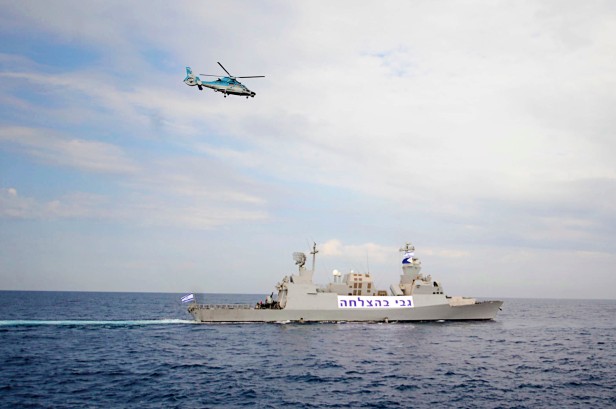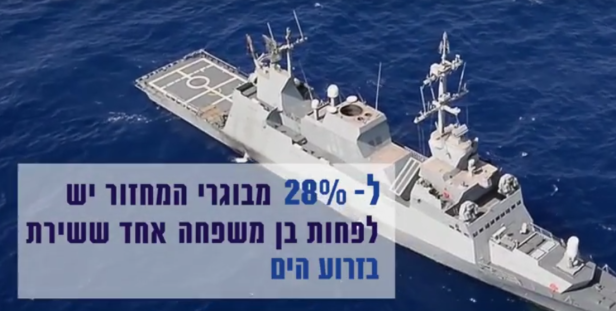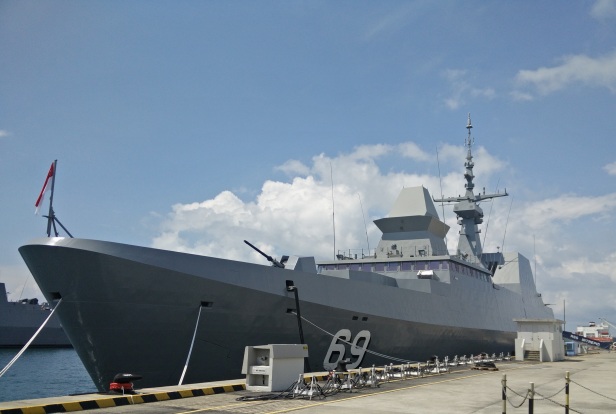The field of advanced weaponry such as anti-ship missiles is rarely a transparent one. Still, the new PTO 2020 is turning out to be quite something, being about as opaque as your favourite Ostrobothnian river following heavy spring rains.
The ANAM / Gabriel 5
The best source on the ANAM that is currently available is likely the single cutaway found on IAI’s homepage. This can then be compared to the dimensions of the Harpoon, which are well-known. Under the assumption that the diameter of the ANAM and Harpoon are similar(ish), which seems reasonable considering their very similar layout, a closer comparison can be made.

My original impression which I voiced in the last blog was that ANAM is longer and with a slightly different arrangement of the fins. Having compared the cutaway of the ANAM with that of the Harpoon (see e.g. Think Defence’s piece on the Harpoon), it does seem clear that this was a mistake, and the ANAM is in fact almost impossible to externally differentiate from the Harpoon. It should be noted that this conclusion rests on the assumption that A) the ANAM cutaway supplied by IAI is at least remotely correct, and B) that the diameter of the missiles are indeed the same. On the first account there does exist a possibility that the supplier isn’t completely honest when it comes to marketing material, but it is an OSINT-risk I am prepared to live with for the time being. On the second account, there seems to be little reason to produce a new weapon so closely modeled after the layout of the Harpoon, unless it is designed to fit the current logistics chain, including storage containers and possibly the launchers themselves. This is as I see it the only possible explanation why the Israelis chose the exact same layout and size of fins to the exact same external body. Small caveat here that the inlet might differ, as it is shrouded by the fins in the cutaway, and a retractable scoop a’la BGM-109G GLCM is a possibility. Something like this is visible in the Skimmer-video referenced in the last post, though it is unclear if that is the ANAM or a generic anti-ship missile (it does look somewhat like IMI’s Delilah HL, but the configuration of the fins is different).
One interesting point that stands out in the cutaway, however, is the internal component layout compared to the non-ER versions of the Harpoon. Crucially, the warhead occupies more or less exactly the same space as the 500 lbs (227 kg) warhead of the Harpoon. If the cutaway is correct, this would indicate that Finland has decided against downsizing the warhead compared to the current MTO 85M. The size of the fuel tank would also likely indicate a range in the 150 km class rather than the 200+ km ranges of the RBS 15 Gungnir, NSM, and Harpoon Block II+ ER. Crucially, as 150 km is more than “about 100 km“, this does not contradict that the PTO 2020 has longer range than the MTO 85M, one of the few capability details revealed by the Finnish authorities (this being confirmed by captain Valkamo).
For the sensors available to the Finnish Navy and for the relatively limited firing ranges of the Baltic Sea, blast size for range isn’t an unexpected trade-off. However, in a field where only the RBS 15 and Gabriel had a 500 lbs warhead, this might certainly have been one of the deciding factors. Notably, the traditionally conservative Finnish Defence Forces seems to continue favouring radar-seeking missiles with large warheads, operating at high-subsonic speeds.
All in all, it does seem likely that at some point after the introduction of the RGM-84D into Israeli service, the Israelis were not happy by the continued development path of the Harpoon, and decided to make a better version on their own (note that “better” might be in the narrow sense of better suiting Israeli requirements). This is not unheard of when it comes to Israeli weapons development (see e.g. Magach contra M60 Patton, or Kfir compared to Mirage V), and would make Gabriel 5 something of a cousin to the Harpoon Block II+ ER.
The DCSA-request
The Harpoon DSCA-request was discussed when it arrived, and while the Harpoon wasn’t picked, it does give some interesting pointers regarding the scope of the Gabriel-deal. It covered 112 live missiles and eight exercise ones, for a total sum of 622 million USD (532 million Euro). This is likely the absolute maximum, and corresponds to the Gabriel order including options. The quoted sum for the latter was 162 million Euros for the firm order and options for an additional 193 million Euros, for a total of 355 millions. In other words, the Israeli offer including options was 40% cheaper than the DSCA-request. Even if there are discrepancies between the two offers, the difference is big enough that the Israeli offer must have been objectively cheaper by all standards.

In Israeli Service
As noted the last time around, the Israeli decision not to upgrade their RGM-84D Harpoons to even -84L standard is rather revealing. In an article from 2014, a ‘senior naval source’ discusses the improvements to the anti-air and land-strike capabilities of the Navy, and reveals that “planned upgrades are also scheduled for sea-to-sea missiles.” These are all part of the “overall strategic vision in which the navy plays a growing role in the IDF’s integrated warfare capabilities.”
In 2017 INS Hanit, an Israeli Sa’ar 5-class vessel, took part in the international exercise ‘Novel Dina 17‘ with a single quadrupel-launcher of a new design (note that at least one of the pictures described as showing the INS Hanit in fact shows a Sa’ar 4.5-class vessel). This was captured on picture by AP press photographer Jack Guez, and labelled as the ‘Missile boxes Gabriel’. The box-shaped launchers have to the best of my knowledge not been seen either before or since. This is not surprising, as their unstealthy and generally crude look does give the impression of them being a test-installation rather than the final mount.

The Sa’ar 5 employs their Harpoons in two stealthy launchers, each holding four missiles. As discussed above, it is possible that the Gabriel can be fired from the same launcher, with only the missile control unit inside the vessel being switched out. As such, identifying which missile is carried based on the launcher is hard to impossible. However, in a YouTube-video posted by the Israeli Navy on their channel in the spring of 2017 a launcher with two longitudinal ‘stripes’ is visible. These might be vents, but in any case they differ compared to the standard version. If they are related to the Gabriel or not is impossible to tell, but there seems to be an upgraded version of the launcher introduced into service within the last year(s).
…and abroad
When Svenska Yle asked the Armed Forces about which other countries use the system, they could only confirm that other countries also use the system. Individual countries could not be mentioned because the information is classified.
An interesting question is where the Gabriel is in operational use. There is a small caveat that since this isn’t a direct quote and the interview might have been conducted in the secondary language of either the journalist or the Defence Forces’ representative, it is possible that this was a misunderstanding. However, the quote above, from an article by the Finnish public broadcasting company YLE, gives the impression that more than one country uses the missile. This obviously raises the question which country that might be?
Books can, and indeed have been, written on Israeli arms trade. In oversimplified terms, Israel is ready to export their weaponry to most anyone who can guarantee that it doesn’t end up in the hands of any of the countries actively promoting the destruction of the Israeli state. In effect, this has lead Israel to exporting arms to numerous countries in Africa, Asia, and South/Central Americas. Deals to western countries usually go through local partners (see today’s announcement about Lockheed Martin cooperating on the SPICE guidance kit). Export of earlier versions of the Gabriel have usually been tied to the export of Israeli surplus naval vessels, something which isn’t the case with the Gabriel 5 as it is so new.
In recent years, three countries stand out when it comes to Israeli exports: India, Vietnam, and Azerbaijan.
The missing link between the jewish democracy of Israel and the muslim dictatorship of Azerbaijan is Iran. Azerbaijan is in fact somewhat western-aligned, in part as neighbours Armenia and Iran are aligned towards Russia, and operate an impressive array of Israeli equipment. This includes Israeli Shaldag-class fast patrol craft and Sa’ar 62-class offshore patrol vessels. The latter are based on the Israeli Sa’ar 4.5-class fast attack crafts, and can likely lay claim to the title of the world’s most heavily armed coast guard vessels. Interestingly, Azerbaijan’s Turan news agency reported in 2011 that the country was buying an unspecified version of the Gabriel (secondary source, primary link broken). As the Sa’ar 4.5 in Israeli service is armed with the Harpoon, it is plausible that the missile system was destined for the Sa’ar 62. However, there are no indication of the system ever having been delivered to Azerbaijan, and the Sa’ar 62 currently operate with the SPIKE-NLOS (as seen in the infamous music video which confirmed the presence of Harop in Azerbaijani service). As such, it seems likely that the Gabriel was axed and replaced by the SPIKE-NLOS in the arms package.
India has bought Barak surface-to-air missiles for their newer vessels, and Vietnam is in the midst of a naval expansion program. While there are reports that some Vietnamese vessels are set to get improved firepower, nothing tangible indicate that the Gabriel would have been exported to either country.
Enter the Singaporean Formidable-class frigates. These are based on the French La Fayette-class, and is certainly one of the most formidable classes in operation in Asia. However, one odd feature is the fact that most sources list their main armament as being the outdated RGM-84C Harpoon, first introduced in 1982 and only marginally better than the original 70’s design of the -84A. While the Singaporean Navy isn’t exactly open with their armament choices, it seems that the assumption is that they share the RGM-84C version with the older Victory- and Sea Wolf-classes (the latter now retired, and curiously enough originally fitted with the Gabriel 2). The continued use of the RGM-84C would place the vessels at something of a drawback in a neighborhood featuring Exocet MM40 Block 2 and NSM, and would seem a strange decision considering the considerable cost sunk into the frigates.
There has been some rumours* that IAI participated in and lost the tender to arm the Formidable-class. Looking back, it might just be that they did participate, but in fact won. And no-one even noticed.



The Singaporean Formidable-class frigates using the Gabriel 5/ANAM is actually a rather plausible theory.
But also, why not the British Type 45 destroyers and the future Type 26 frigates? It’s said that they have just old Harpoon launchers recycled from the decommissioned Type 22 frigates – and there’s been high obscurity regarding the ASM armament of both of the classes in general. After a request based on the British Freedom of Information act, only that the Type 45 class use recycled launchers was revealed, not even the missile type. What is even more odd is that the Royal Navy has said that their Harpoon Block 1C missiles (RGM-84D) were to be taken out of service in 2018, and they made a deal with Boeing to just to supply the launchers with spare parts at the price of US$ 2.5M, which isn’t enough for any missiles. Curiously, that’d leave the Royal Navy without an ASM for over 10 years or so.
https://ukdefencejournal.org.uk/united-kingdom-purchases-harpoon-missile-upgrades-support/
The British also have a history of secrecy of arms deals with Israel, most notably the British using the Spike NLOS system (under the name Exactor), for 4 years even before the existence of the whole Spike NLOS system was revealed by Israel.
Unlikely as the firing tubes are standard Harpoon and never trust Singapore the father of FAKE news. The tech on the Formidable class is less advance than the RTN Naresuan Class Frigate
The 2 RTN Naresuan class Frigates, is a modified version of the Chinese-made Type 053 frigate, built by the China State Shipbuilding Corporation in Shanghai. The ships came at 2 billion baht each, less than the 8 billion baht price tag for Western-built frigates. The Thai Navy complained of the poor quality of the ships. The ship’s damage control system was very limited, with very basic fire suppression systems. It was stated that if the ship’s hull was breached, the ship would be quickly lost to flooding. The Thai Navy had to spend considerable time and effort to correct some of these issues using western technologies.
On the other hand, the 6 Singapore Navy Formidable class stealth frigates are the most modern and heavily armed vessels in Asia. It carries the Heracles long range radar and the Aster 15/30 combination missile system. After the Malaysia planned acquisition of the NSM, It was announced that the Formidable class are armed with the Gabriel 5 LRM of which it can carry 24 missiles per ship using the same harpoon launch canisters.
Nope it still has harpoon as I said Singapore is the father of Fake news when it comes to the military. Narasuan is much more advanced it has been upgraded with the most advanced systems in SE Asia 2nd only to the new RTN frigate
Naresuan Class Guided-Missile Frigates (F 25T) https://thaimilitaryandasianregion.wordpress.com/2017/04/23/naresuan-class-guided-missile-frigates-f-25t-thailand/ , Formidable Class Frigate https://thaimilitaryandasianregion.wordpress.com/2017/04/17/formidable-class-frigate-singapore/
In light of the new info released by the Finnish MoD which pointed to a completely different beast than a Harpoon-like missile that you suggested, will you either refresh this article or write a new piece? Cheers
The only piece of information pointing to a completely different beast was the weight, which likely refers to the total system weight (i.e. canister + missile) and not the missile launch weight is usually the case. As such I still believe this post to be largely correct, and don’t really have enough information to create a completely new post.
I Was right All along in saying that the Singapore Navy was using Gabriel 5 on their Formidable class frigate as well as on their corvettes. It was announced today, a JV Company Between ST Singapore and IAI Israel who Worked on the Blue Spear anti ship missile ( Gabriel 5 ) for many years and It is operational, This missile Will be marketed for the export Market. This indicate the missiles are already in the Singapore Navy inventory.
A certain ladyboy would disagree on anything related to singapore though.